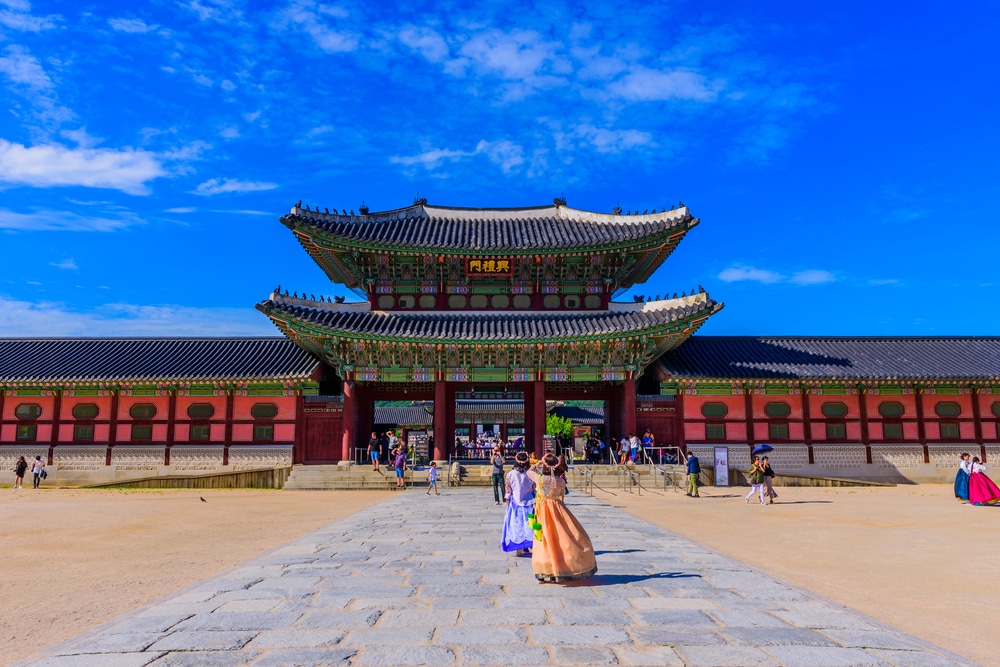
100+ Korean Travel Phrases
One often-overlooked aspect of preparing for travel is learning a bit of the local language.
While English will get you quite far in South Korea (especially in the bigger cities), nothing can replace learning a little Korean to get around. It can make things easier for you, and the natives will appreciate the effort!
Here’s a list of essential phrases to get you started.
Contents
- Basic Greetings
- Common Courtesy
- Communicating in Korean
- Important Places
- Navigating Around
- Transportation
- Accommodations
- Tourist Attractions
- Dining
- Shopping
- Emergency Situations
- Travel Essentials
- Miscellaneous
- And One More Thing...
Download: This blog post is available as a convenient and portable PDF that you can take anywhere. Click here to get a copy. (Download)
Basic Greetings
The bare fundamentals, a simple “Hello” or “Goodbye,” can be much appreciated by any native speaker.
안녕하세요 — Hello
This can be said at any point in the day, and you can reply to this in exactly the same manner.
반갑습니다 — Nice to meet you
If you meet someone, especially someone of importance, you can illustrate your respect with this short phrase.
어떻게 지내세요? — How are you?
잘 지내요 — I am good
A positive response to the above question of “How are you?”
이름이 뭐예요? — What is your name?
This is a polite way to ask, but if you want to be more casual, you can say 이름이 뭐야? instead.
제 이름은 _____ — My name is _____
안녕 / 안녕히 계세요 / 안녕히 가세요 — Goodbye
“Goodbye” comes in different flavors in Korean. 안녕 is informal and should be used for friends and closer acquaintances. 안녕히 계세요 (lit. “Please stay well”) is specifically for when you are leaving the premises, but the other person is staying. Conversely, 안녕히 가세요 (Please leave well) is when you are staying, but the other person is leaving.
좋은 아침 — Good morning
If it’s your first time seeing someone in the morning (up until 11 AM), you can greet them with this since it’s pretty common.
좋은 저녁 — Good afternoon
These two phrases aren’t used as much as a general 안녕하세요 (Hello), but you’re more likely to come across them in formal situations, such as a work event.
Common Courtesy
South Korea holds courtesy in high regard, so you’ll definitely want to learn some ways to express gratitude and respect. Doing so, especially when you’re a foreigner, will help you leave a good impression on those you interact with.
감사합니다 — Thank you
This is a formal, all-around safe way to offer your gratitude. Alternatively, you may say 고맙습니다 .
천만에요 — You’re welcome (formal)
It’s not often that Koreans actually respond to a “Thank you” with a “You’re welcome,” but if you wish to be extra polite, then you can throw in this phrase. Normally, you can respond to thanks with a simple, humble 아닙니다 , which means “It’s nothing.”
실례합니다 (polite) / 잠시만요 — Excuse me
실례합니다 is a very polite phrase used to get someone’s attention, such as for when you approach a stranger for help. 잠시만요 more or less means “Wait a moment” but can be used for situations such as when you need to push past or be a minor physical hindrance to people.
여기요 — Over here
Use this phrase with a raised hand or some kind of physical gesture to get someone to come over to you. This can also be used to flag down a waiter in a restaurant.
Used for any situation where you need to excuse your behavior. Both ways of saying sorry are formal and have an almost equal amount of weight (are interchangeable).
[object] + _____ 주세요 — Please give _____
Use this if you’re politely requesting an object from another person. This can be said alone, or follow after you specify what you want.
To learn more about how to be polite in Korean—and listen to how some of the super common situations in this post sound in real life—you can use a learning program like FluentU.
FluentU takes authentic videos—like music videos, movie trailers, news and inspiring talks—and turns them into personalized language learning lessons.
You can try FluentU for free for 2 weeks. Check out the website or download the iOS app or Android app.
P.S. Click here to take advantage of our current sale! (Expires at the end of this month.)
Communicating in Korean
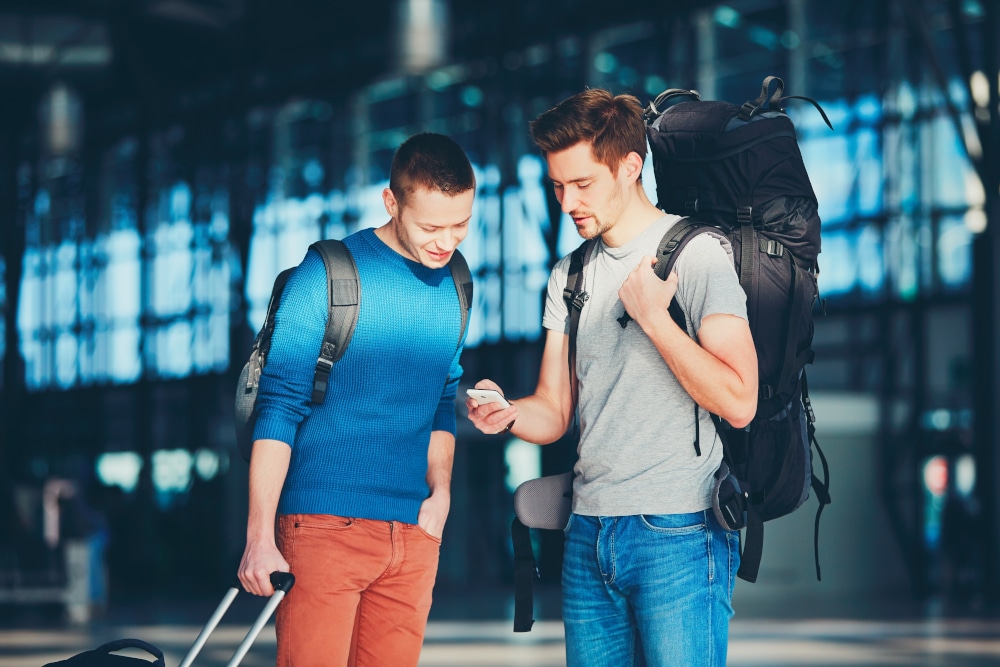
Getting confused is an unavoidable experience when traveling to another country that speaks a different language! By knowing some key vocabulary, though, you can make communication easier.
잘 모르겠네요 — I don’t understand
한국말 잘 못해요 — I don’t speak Korean well
It’s highly likely that you won’t understand every word of Korean you hear, and it’s best to let whoever’s talking to you know that! Many will be kind enough to try and simplify their message for your comprehension.
영어 할 수 있어요? — Do you speak English?
Most Korean natives know some English to be able to help you out in a tough spot, so don’t be afraid to ask!
천천히 말씀해 주세요 — Please speak slowly
다시 한 번 말해주시겠어요? — Can you please say that again?
Korean is a rather quickly-spoken language, especially when the speaker is quite emotional (Korean dramas, anyone?), so keep these two phrases in mind just in case.
종이에 적어 주세요 — Please write it down
This is essential when you’re asking about the name of a place or getting someone’s phone number.
Important Places
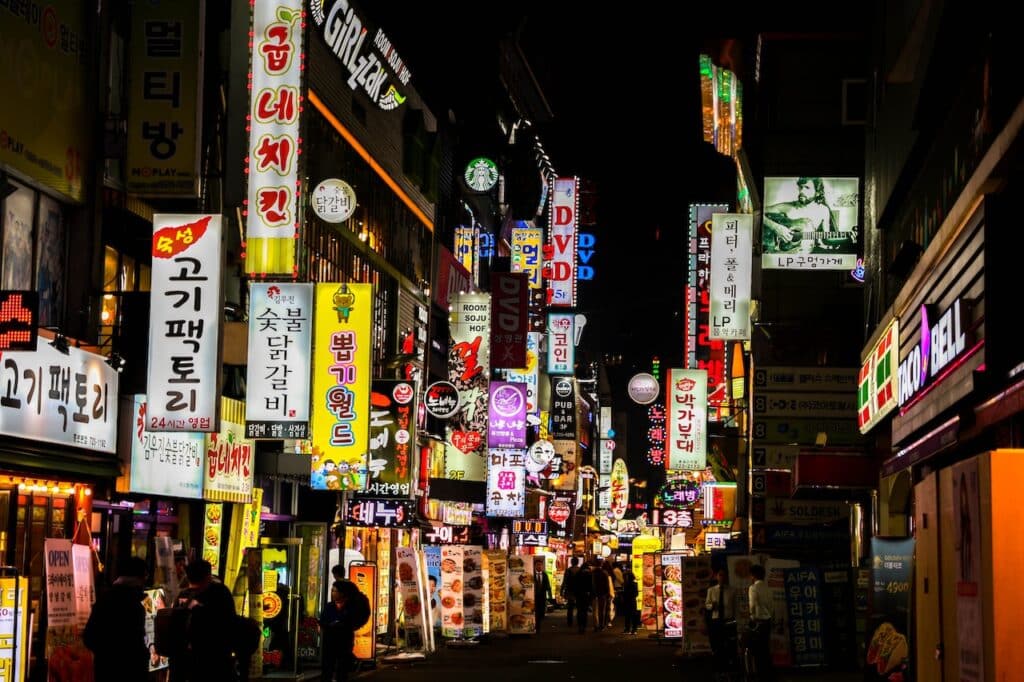
Wherever you’re going in Korea, some of the most helpful vocabulary to know would be place names:
- 지하철역 — Subway station
- 기차역 — Train station
- 버스 정류장 — Bus station
- 공항 — Airport
- 은행 — Bank
- 호텔 — Hotel
- 호스텔 — Hostel
- 식당 — Restaurant
- 카페 — Cafe
- 관광 안내소 — Tourist information center
- 박물관 — Museum
- 공원 — Park
- 시장 — Market
- 약국 — Pharmacy
- 편의점 — Convenience store
- 해변 — Beach
- 쇼핑 센터 — Shopping center
Navigating Around
Even if you go off-track at some point or lose your way, don’t worry—getting lost can make for a great adventure in your travels and be a perfect opportunity for you to practice your Korean with locals.
왼쪽 / 오른쪽 / 직진 — left / right / straight
북쪽 / 남쪽 / 동쪽 / 서쪽 — north / south / east / west
These direction words are self-explanatory, and if you’re asking for directions, you’ll most definitely be hearing these words. Make sure to be familiar with them so you can at least pick up general directions.
근처에 _____ 이(가) 있나요? — Is there a _____ nearby?
This will tell any native that you’ll need some navigation help. Follow up with something that will indicate where you’d like to go.
_____이(가) 어디인지 아세요? — Do you know where _____ is?
어떻게 _____ 에 가나요? — How do I get to…?
Ask any of these two phrases for specific directions.
_____이(가) 얼마나 먼가요? — How far is _____?
_____ 까지 얼마나 걸려요? — How long does it take to get to _____?
It might feel quite different from English, but you’d put the name of the place at the start. You can use the table in the previous section as a reference!
_____ (으)로 가 주세요 — Please take me to _____
If you need a guiding hand, then this will be the phrase to use. You can quickly find people willing to direct you to where you need to go. This phrase can also be used to inform a taxi driver of your destination. (When the place name ends with a consonant, use “으로,” otherwise use “로.”)
화장실이 어디예요? — Where is the bathroom?
Because in the world of travel, being able to find a bathroom is essential. Note that 어디예요 , by itself, means “where is it.”
Transportation
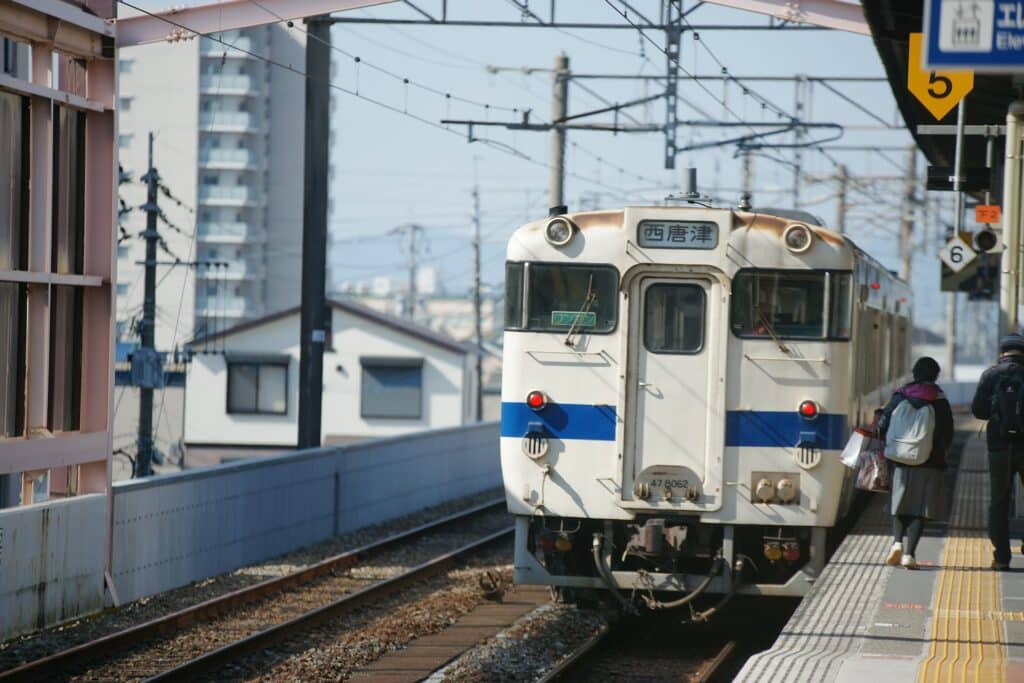
South Korea has a convenient transportation system that also makes it easy to travel from city to city. Here are the main forms of transportation:
These phrases will help you get around:
버스 정류장이 어디에 있나요? — Where is the bus station?
기차역이 어디에 있나요? — Where is the train station?
지하철역이 어디에 있나요? — Where is the subway station?
Bus stations are pretty much everywhere, while subway stations are only in major cities like Seoul, Busan and Daegu. Train stations are inter-city and meant for long-distance trips so they’re a bit more spread out.
표를 예매하고 싶어요 — I want to book a ticket
Aside from a simple ticket, you can also get a transportation card ( 교통 카드 ), which covers both train and bus trips.
표는 어디서 살 수 있나요? — Where can I buy tickets?
Bus or train stations usually have ticket machines, but tickets are available online too, which might be more convenient.
버스가 몇 시에 도착하나요 ? — What time does the bus arrive?
버스는 몇 시에 출발하나요? — What time does the bus depart?
다음 버스는 몇 시에 있나요? — What time is the next bus?
You can replace 버스 (bus) in these sentences with 기차 (train) or 지하철 (subway). For real-time bus or train scheduling updates, locals often check apps like Kakao Map and Naver Map.
[place] + 로 가려면 어떤 버스를 타야 하나요? — Which bus should I take to go to [place]?
이 버스는 _____ (으)로 가나요? — Does this bus go to _____?
It’s not uncommon to get lost! The bus system in Korea can be confusing at first because it uses numbers to represent routes.
You’d mainly say this when riding a taxi. For extra politeness, you can add 주세요 , which means “please,” at the end.
택시 요금은 얼마예요? — How much is the taxi fare?
Most taxis use the meter to track payment, but to avoid confusion, it’s best to ask the driver before you get in around how much it’ll cost. Remember too that you don’t have to tip taxi drivers in Korea!
Accommodations
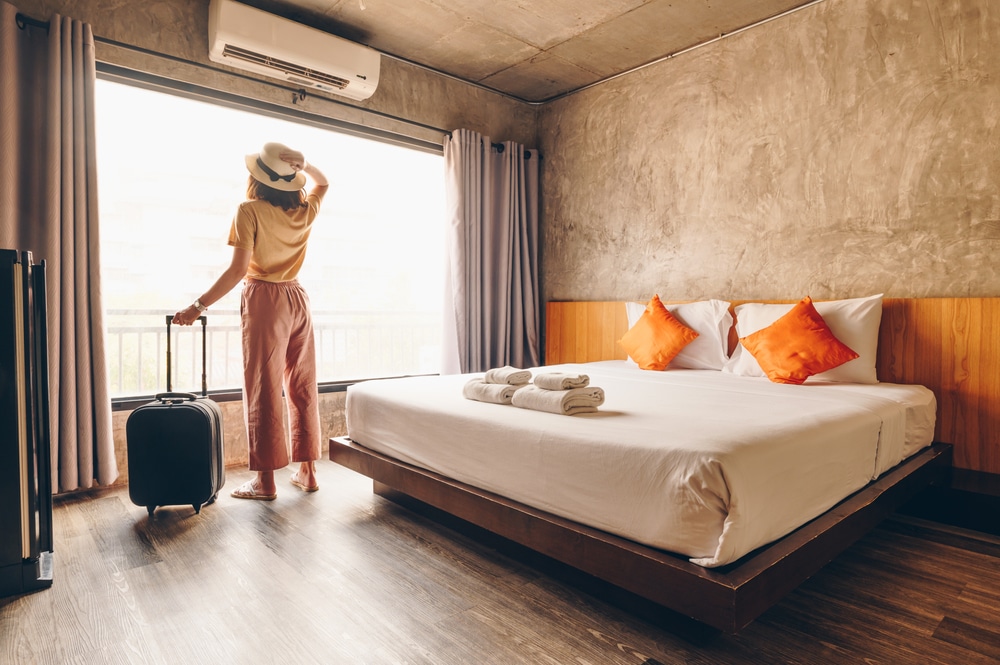
Settle into your accommodations more quickly and move on to exploring with the practical phrases below:
체크아웃 / 체크인 시간은 언제인가요? — What time is check-out / check in?
룸 서비스를 이용하고 싶어요 — I would like to use room service
Depending on the hotel, 룸 서비스 usually means food from the in-hotel restaurant, amenities like towels and blanket and sometimes laundry service.
추가 비용이 있나요? — Is there an additional charge?
Sometimes this isn’t obvious, such as when you’re getting drinks from the minibar.
_____을(를) 추가로 받을 수 있을까요? — Can I have more _____?
You can usually ask for items like 타올 (towels), 물 (water), 이불 (blankets), 베개 (pillows), 샴푸 (shampoo), 비누 (soap), 칫솔 (toothbrush) and 치약 (toothpaste).
전기 변압기가 필요해요 — I need an electrical adapter
Most hotels have extra adapters on hand since it’s a common request.
방을 변경하고 싶어요 — I would like to change my room
택시를 부르고 싶어요 — I would like to call a taxi
와이파이 비밀번호가 무엇인가요? — What is the wi-fi password?
Having internet access is pretty much invaluable when you’re in a foreign city, so this is worth remembering not just for hotels, but also for when you’re out and about.
Tourist Attractions
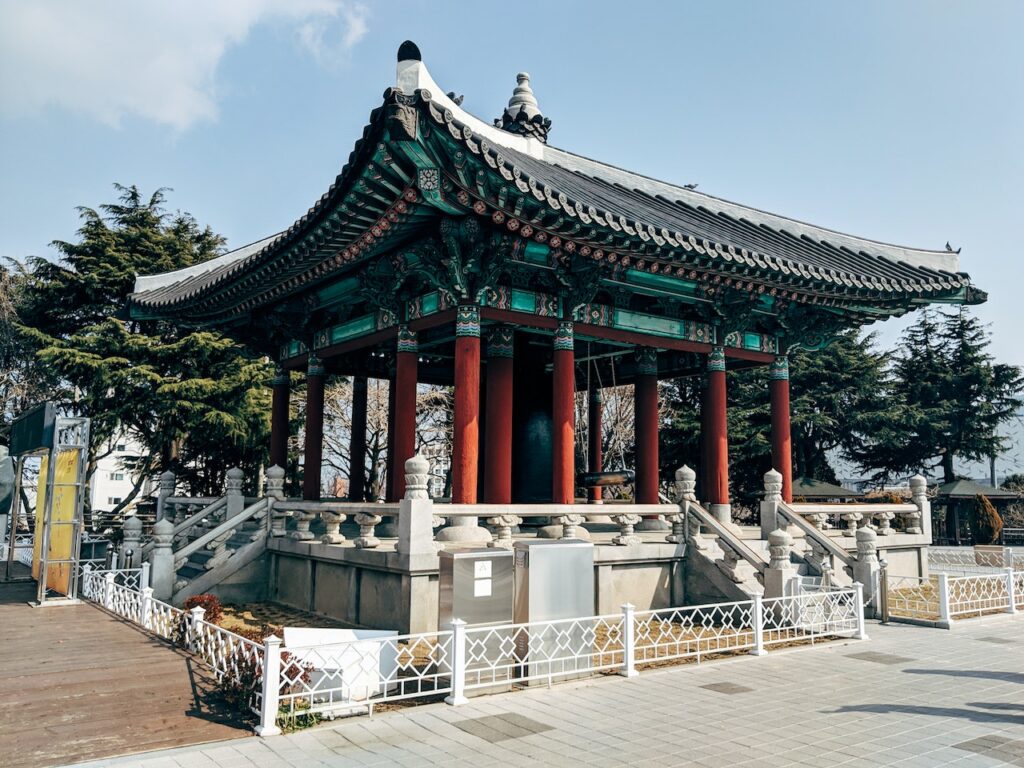
Whether you’re going to a heritage site, museum, theme park or traditional village, these phrases will let you make the most out of your visit.
이곳은 언제까지 열려 있나요? — Until what time is this open?
가이드 투어가 있나요? — Is there a guided tour available?
Major museums, palaces and cultural heritage sites often have guided tours in English, such as Gyeongbokgung Palace ( 경복궁 ) and National Museum of Korea ( 국립중앙박물관 ).
사진 찍어 주실 수 있나요? — Can you take a photo of us?
Unless you have a lengthy selfie stick, you’ll likely have to make this request to strangers. If you’re not sure whether you can take photos, you can ask the staff 사진을 찍어도 되나요? to confirm.
입장료는 얼마예요? — How much is the admission fee?
This works for pretty much any tourist attraction and even performances and concerts.
티켓을 구매하고 싶어요 — I would like to purchase a ticket
_____ 장 주세요 — _____ ticket/s, please
When buying tickets, just place the number before 장 주세요. For example, for one ticket, you’d say 한 장 주세요 , while for two or three tickets, it’d be 두 장 주세요 or 세 장 주세요 respectively.
할인 티켓이 있나요? — Do you have any discounted tickets?
어린이 요금이 어떻게 되나요? — What is the children’s fare?
경로 요금이 어떻게 되나요? — What is the senior’s fare?
If you’re buying tickets as a group or you’re with children or seniors (60 years old and above), you might get a discount.
안내 지도를 얻을 수 있을까요? — Can I get a map?
명소를 추천해 주실 수 있나요? — Can you recommend some attractions?
근처에 추천해 줄 식당이 있나요? — Can you recommend any restaurants nearby?
Asking locals for recommendations can point you to cool spots that you won’t find easily online, and they might give you practical tips too.
Dining
South Korea is a food-lover’s paradise. On every street, you’ll find indoor and outdoor food venues, selling everything from traditional Korean meals to trendy snack foods. These phrases will help you when you’re up for some indulgent dining.
_____ 주세요 — Please give me _____
To order your meal, simply state it and tack on 주세요 afterwards. Short and simple!
메뉴 주세요 — Menu, please
More often than not, Korean restaurants won’t have the menu out on the tables. To get one, simply raise your hand and state this phrase.
계산서 주세요 — Bill, please
Waiters in Korean restaurants often will not personally ask if you’ve finished your meal, so once your stomach is satisfied and you’re ready to head out, ask for the bill!
싸 주세요 — Please wrap / It’s to-go
If you want wrapped leftovers, you definitely have to let your servers know as they probably will assume otherwise. Note that you’ll likely only get your meal, not any side dishes, packed up.
제가 알레르기가 있어요 — I have an allergy
If you have an allergy, then you must say so, preferably in Korean so that they know exactly what to exclude.
어떤 음식을 추천하시나요? — What food do you recommend?
Asking for the staff’s recommendations is one of the surest ways to try what’s good in a restaurant.
영어 메뉴가 있나요? — Is there an English menu?
Restaurants that get plenty of travelers are likely to have English menus.
좀 덜 맵게 해 주세요 — Please make this dish less spicy
Korean food can be quite spicy, so you can make this request if you prefer milder flavors. To minimize the spiciness, you can even say 안 맵게 해 주세요 — Please make this dish not spicy.
예약했어요 — I made a reservation for a meal
따로 계산해 주세요 — Please separate the bill.
This is for when you want to split the bill and get separate receipts for less hassle.
물 한 잔 주세요 — Please give me a glass of water
A lot of Korean restaurants have water stations or dispensers so you can get water whenever you want. In case there’s none, though, you can ask the staff directly since it’s usually free.
얼마나 기다려야 하나요? — How long do I have to wait?
Thankfully, once you’re at the table, 반찬 or side dishes tend to be served pretty quickly, so you can munch on something while waiting for your order.
젓가락 하나 더 주세요 — Please give me an extra pair of chopsticks
숟가락 하나 주세요 — Please give me a spoon
Chopsticks and spoons are the main utensils in restaurants in Korea. Note that 포크 or forks are less common in traditional restaurants!
Since eating out is likely going to be a major part of your itinerary, here are some more survival Korean expressions for ordering food:
Shopping
With its plethora of food establishments, South Korea also has a huge variety of shopping outlets. You definitely won’t get bored by what’s available for purchase, so you’ll want to know what exactly to say when something catches your eye and makes you reach for your wallet.
_____ 있어요? — Do you have _____?
얼마예요? — How much is it?
It’s highly recommended to know how numbers work in Korean, as there are two distinct systems that are used in different contexts. However, if you’re not overly familiar with them, it’s probable that the cashier will be able to tell you the price in English.
카드 받으세요? — Do you take credit cards?
South Korea has a high credit card usage rate, so you shouldn’t have a problem if you’re strapped for cash and only have your card on hand.
환불해 주세요 — Please give me a refund
Be prepared with a good reason for your request! Even if you’re a foreigner, you’ll still need to explain yourself (and explain well!) to the store employee.
교환해 주세요 — Please give me an exchange
If your shopping purchase is damaged or needs to be switched to fit your needs, then use this phrase to notify the employee. You shouldn’t have a hard time with this request, especially if you have a valid reason.
할인해 주실 수 있나요? — Is there a discount?
You never know when there might be a sale or promo!
이거 더 작은 사이즈로 있나요? — Do you have this in a smaller size?
이거 더 큰 사이즈로 있나요? — Do you have this in a bigger size?
Korea’s size system for clothes can seem very familiar at first because it also uses letters like S, M and L. Sizes can be different from those in other countries, though, so you’ll definitely want to try on the clothes first before buying them! Some stores have free alteration services too.
피팅룸은 어디에 있나요? — Where are the fitting rooms?
이거 살게요 — I’ll buy this
When you’re done at the fitting room and you’re satisfied with the clothes, then you can let the store employee know.
Emergency Situations
In the event that an urgent situation pops up and you’re in need of direct, quick help, you’ll need some quick phrases to get proper attention.
도와주세요! — Help!
A straightforward call for assistance. This literally means “Give me help,” to which a proper response might be 도와줄게요 , which means “I will give you help.”
긴급 상황이에요 — It’s an emergency
Whatever the nature of your problem, this phrase will get you rapid assistance. Consider who exactly you need to help you, whether it’s the police or the paramedics, for example.
경찰 / 경찰을 부르세요 — Police / Call the police
It’s helpful to know that in South Korea, the phone number to contact the police is 112. But in case you don’t have a phone or are in quick need of legal service, saying the above phrase to a native will most likely get the help you need.
병원 — Hospital
If you say this phrase alone to a native, that could be enough of an alert for them to aid you. If you need quick medical attention and know you need care at a hospital, then use this phrase.
여기가 아파요 — It hurts here
This is useful for any injury you receive that needs to be treated. Along with this phrase, point to where exactly you feel pain.
의사가 필요해요 — I need a doctor
Along with the word for hospital, this is good to know if there’s ever a possibility that you need professional care. It’s possible someone will call an ambulance for you, should the situation be dire, but you should also know that the Korean phone number for the fire brigade and ambulance services is 119.
Travel Essentials
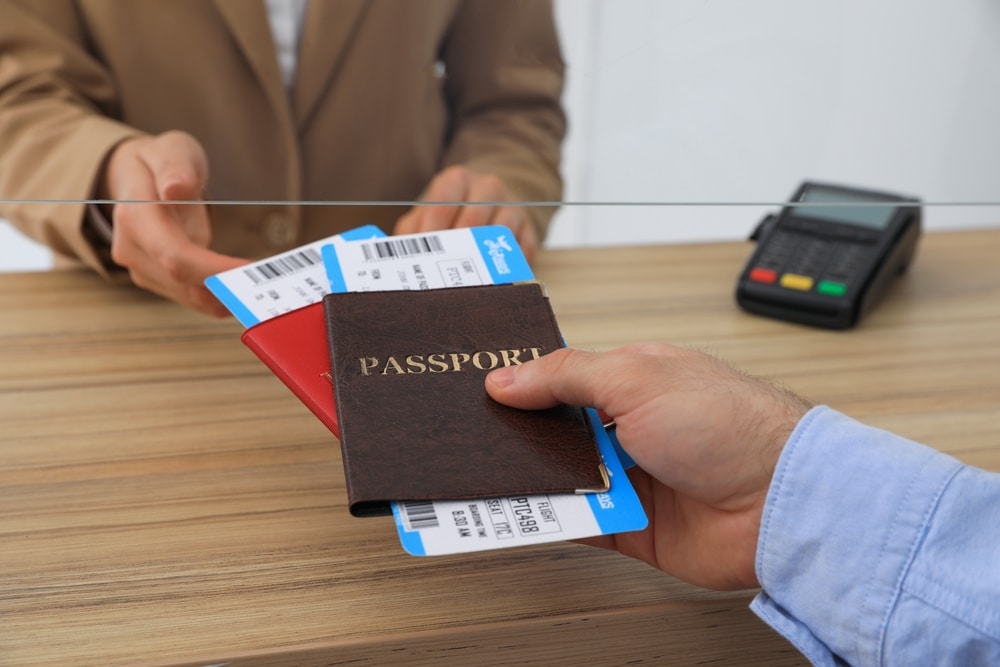
Your passport is the most important document to have while traveling, so here’s some helpful vocabulary:
여권 — Passport
This can be useful to know how to say in Korean because some places—like hotels and bars—might look for your passport. A related word is 비자 (visa).
여권 잃어버렸는데, 보셨나요? — I lost my passport, have you seen it?
Fingers crossed that this won’t actually happen! If you lose something else, you can replace 여권 (passport) in this sentence. Other valuables are 지갑 (wallet), 핸드폰 (mobile phone), 신용카드 (credit card) or 가방 (bag).
[Your country] 대사관은 어디에 있나요? — Where is the… embassy?
If you lose your passport or get visa-related issues, then you’ll have to head to your country’s embassy in Korea.
환전소는 어디에 있나요? — Where is the currency exchange?
Aside from banks, you can get currency exchange done at the airport, hotel and major shopping centers. Look for signs that say 환전 or 외화 교환 , which both mean currency exchange.
Miscellaneous
Here are some phrases you may hear anywhere, anytime, and aren’t necessarily attached to any one context.
화이팅! / 파이팅! — Fighting!
Slang used for encouragement, you can passionately exclaim this to boost one’s morale. It’s usually accompanied nu a firm shake of the fist.
괜찮아요 — It’s okay
The equivalent to the English “It’s fine.” You can say this in a multitude of situations, such as expressing the state of your physical health or accepting a certain circumstance.
진짜요? — Really?
Just in case you need some extra affirmation about something. This phrase is also commonly used as an exclamatory statement.
안 돼요 — It doesn’t work/It cannot (be)/No way
This phrase differs slightly in meaning depending on the context. You can use it for a variety of situations, from talking about a dysfunctional washing machine to adamantly denying a particular circumstance.
재미있어요 — It’s fun
Of course, if you’re having fun and want to say so, then by all means you should! This phrase will be relevant quite frequently while you’re out and about adventuring in Korea.
With these phrases as part of your mental luggage, you’ll be more confident and have a more satisfying trip to Korea.
Safe travels, or as you would say in Korean, 여행 잘 하세요, 조심해서 가세요 !
Download: This blog post is available as a convenient and portable PDF that you can take anywhere. Click here to get a copy. (Download)
And One More Thing...
If you enjoyed this post, you're already halfway to having the time of your life learning Korean with FluentU!
FluentU makes it possible to learn with K-pop videos, funny commercials, entertaining web series and more. Just a quick look will give you an idea of the variety of FluentU videos on offer:

FluentU really takes the grunt work out of learning languages, leaving you with nothing but engaging, effective and efficient learning. It's already hand-picked the best videos for you (which are organized by level and topic), so all you have to do is simply choose any video that strikes your fancy to get started.
Each word in the interactive captions comes with a definition, audio, image, example sentences and more.

Access a complete interactive transcript of every video under the Dialogue tab, and easily review words and phrases from the video under Vocab.

You can use FluentU’s unique Quiz Mode to learn the vocabulary and phrases from the video through fun questions.

FluentU keeps track of what you're learning, and tells you exactly when it's time for review, giving you a 100% personalized experience.
Review sessions use video context to help embed the words in your memory.
Start using the FluentU website on your computer or tablet or, better yet, download the FluentU app from the iTunes or Google Play store. Click here to take advantage of our current sale! (Expires at the end of this month.)










